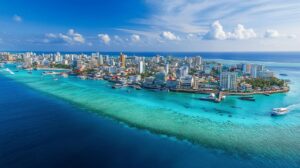Stepping into Malé, the beating heart of the Maldives, is like discovering a world that defies every expectation of this island nation. Whilst many travellers rush straight from Velana International Airport to their resort islands, those who linger in this densely populated city find themselves immersed in a vibrant tapestry of local life, rich history, and authentic culture. Malé Island, perched at the southern tip of North Malé Atoll, offers an extraordinary contrast to the serene overwater villas and deserted sandbanks that dominate brochures. Here, amid narrow streets and bustling markets, you can experience the genuine rhythms of Maldivian life, where tradition and modernity collide in the most fascinating ways.
Historic henveiru: where tradition meets modern island living
Henveiru stands as one of the four main wards of Malé Island, a neighbourhood where the past whispers through every corner whilst contemporary island life surges forward. Walking through these streets, you encounter a living museum where the old and new coexist in remarkable harmony. The area has witnessed the transformation of Malé from a modest settlement to a thriving capital, with its population swelling from around forty thousand residents in the late twentieth century to well over three hundred thousand today. This rapid growth has shaped Henveiru into a fascinating blend of historical preservation and urban evolution, where traditional Maldivian architecture shares space with modern developments that accommodate the city's ever-expanding community.
Exploring the Old Friday Mosque and Local Markets
The Old Friday Mosque, known locally as Hukuru Miskiiy, represents one of the most significant landmarks in Henveiru and indeed across the entire Maldives capital. This centuries-old structure, with its intricate coral stone carvings and elegant craftsmanship, stands as a testament to the deep Islamic heritage that defines Maldivian culture. The mosque's walls tell stories of devotion and artistry, with each carved panel reflecting the skilled hands of craftsmen who worked long before the tourism economy transformed these coral atolls into a global destination. Visitors who explore this sacred space gain insight into the spiritual foundation that continues to shape daily life in Malé, where Islam remains the official religion and influences everything from the modest dress code to the rhythm of daily prayers that punctuate the soundscape of the city.
Just a short stroll from the mosque, the local market bursts with the colours, sounds, and aromas that define authentic Maldivian commerce. Here, vendors display their wares with pride, offering everything from fresh tuna caught that very morning to vibrant textiles and handcrafted goods that make perfect souvenirs. The fish market, in particular, provides an unforgettable sensory experience, where the fishing industry that once dominated the Maldives economy remains on full display. Locals and visitors alike navigate the bustling aisles, bargaining over prices and selecting the freshest catches, whilst the constant activity creates an atmosphere of organised chaos that somehow works perfectly. This is where you witness the genuine economic pulse of Malé, far removed from the polished tourist experience of resort islands, and it offers a glimpse into how the city sustains itself beyond the revenue from international visitors.
Authentic maldivian cuisine in hidden henveiru eateries
Whilst Malé itself does not offer alcohol, respecting the Islamic traditions that govern the capital, the culinary scene in Henveiru compensates with flavours that celebrate the rich bounty of the Indian Ocean and the cultural influences from the Indian Subcontinent and beyond. Small eateries tucked away in residential streets serve dishes that have been passed down through generations, with recipes that blend local fish with aromatic spices, coconut, and fresh produce. These hidden gems offer meals for remarkably modest prices, often around five to seven dollars, making them accessible to budget travellers who want to taste genuine Maldivian cooking without the inflated costs of tourist-focused establishments.
The neighbourhood tea shops scattered throughout Henveiru provide another layer of local life experience, where residents gather throughout the day to sip sweet tea, nibble on short eats, and exchange news and gossip. These informal social hubs operate from early morning until late evening, serving as community centres where the everyday island rhythms become most apparent. For visitors willing to venture beyond the well-trodden paths, these tea shops offer an opportunity to sit alongside locals, observe the ebb and flow of daily routines, and perhaps strike up a conversation that reveals insights no guidebook could provide. The tropical monsoon climate means that even during the wet season, these establishments remain lively, with patrons ducking in from sudden downpours before resuming their day once the rain passes.
Machangolhi: the vibrant cultural heart of malé
Machangolhi represents the cultural and civic centre of the Maldives capital, where institutional landmarks and public spaces converge to create a neighbourhood that feels both grand and approachable. This ward houses many of the city's most important buildings and monuments, making it an essential stop for anyone seeking to understand the historical and cultural foundations of the nation. The area reflects the administrative and educational progress of the Maldives, which boasts a high literacy rate of around ninety-eight percent, supported by institutions such as the Maldives National University and numerous schools that offer instruction in both Dhivehi and English. Walking through Machangolhi, you encounter a level of civic pride that manifests in well-maintained public spaces and monuments that commemorate significant moments in the nation's history.
Sultan Park and the National Museum's Treasures
Sultan Park offers a verdant oasis amid the dense urban landscape of Malé, providing a welcome respite from the constant activity of the surrounding streets. This public garden, which requires a modest entry fee of around five dollars, features shaded pathways, tropical plants, and quiet corners where visitors can pause to appreciate the natural beauty that thrives even in this densely populated city. The park serves as a gathering place for families, couples, and solitary wanderers who seek a moment of tranquillity before returning to the bustling streets beyond its gates. The careful maintenance of Sultan Park reflects the municipal commitment to preserving green spaces despite the severe land constraints that come with being one of the world's most densely populated cities, with over one hundred and thirty thousand residents squeezed into less than two square kilometres of Malé Island alone.
Adjacent to the park, the National Museum stands as the premier institution for understanding Maldivian history and culture. The entry fee of one hundred Maldivian Rufiyaa, roughly six dollars, grants access to collections that span centuries, from pre-Islamic artefacts to royal regalia from the sultanate era. The museum's exhibits chronicle the arrival of the first settlers, believed to be Dravidians from the Indian Subcontinent and Ceylon, and trace the evolution of these coral atolls from scattered fishing communities to the unified nation that exists today. Visitors who pay an additional dollar for photography privileges can capture images of intricately carved wooden panels, ancient coral stone carvings, and historical documents that illuminate the journey of the Maldivian people. The museum also addresses more recent history, including the impact of the devastating tsunami that struck in the early twenty-first century, commemorated elsewhere in the city by the Tsunami Monument that stands as a sobering reminder of nature's power.
Colourful streets and contemporary island architecture
Beyond the formal institutions, Machangolhi captivates with its streets that burst with colour and character. Buildings painted in vibrant hues of turquoise, coral pink, sunny yellow, and deep blue create a visual feast that contrasts sharply with the endless azure of the surrounding ocean. This architectural exuberance reflects a relatively recent trend, as Malé has embraced bold aesthetics that make the city instantly recognisable in photographs and memorable for visitors who wander its lanes. The colourful facades also serve a practical purpose, helping to distinguish buildings in a city where space constraints mean structures often stand shoulder to shoulder with barely a gap between them.
Contemporary island architecture in Machangolhi demonstrates how the city has adapted to its unique challenges. With land at an absolute premium, buildings rise vertically, maximising every square metre of available space. The innovative approaches to urban planning include the ambitious land reclamation projects that have created additional islands such as Hulhumalé and Hulhulé, now connected to Malé by the impressive Sinamalé Bridge. This infrastructure achievement not only facilitates transport between the airport and the capital but also symbolises the forward-thinking approach that has allowed the Maldives to expand its urban footprint without compromising the delicate coral atolls that form the foundation of the nation. Walking through Machangolhi, you witness this balance between preservation and progress, where historical mosques stand metres away from modern commercial buildings, and where the call to prayer mingles with the sounds of construction that signal ongoing development.
Galolhu: waterfront wonders and diving gateways
Galolhu stretches along the waterfront, offering panoramic views of the harbour and serving as the primary gateway for travellers embarking on marine adventures. This ward buzzes with the constant movement of ferry transport, speedboats, and the occasional seaplane that skims across the water before lifting into the sky. The proximity to the ocean defines every aspect of life in Galolhu, from the salt-tinged breeze that sweeps through the streets to the livelihoods of residents who depend on the sea for both sustenance and income. The fishing industry remains vital here, with daily catches of tuna and other species destined for both local consumption and export to trade partners including China, India, and the United Arab Emirates. For visitors, Galolhu represents the starting point for some of the most memorable experiences the Maldives has to offer, from snorkelling adventures to island hopping excursions that reveal the stunning diversity of the surrounding atolls.
Accessing the Capital's Best Dive Spots and Marine Adventures
The waters surrounding Malé teem with marine life, and Galolhu serves as the launching point for excursions that take full advantage of this underwater wealth. Numerous operators based in this neighbourhood offer snorkelling and diving trips to nearby reefs, where vibrant coral gardens and schools of tropical fish create scenes of almost surreal beauty. Many of these house reefs lie just minutes away by speedboat, making it possible to enjoy a morning dive and return to the capital in time for lunch. The affordability of these adventures makes them accessible to budget travellers, with prices significantly lower than equivalent experiences arranged through resort islands, though transfers to those resorts from Velana International Airport typically take only fifteen to thirty minutes by speedboat.
Island hopping tours organised from Galolhu allow visitors to explore the broader Kaafu Atoll, venturing to both inhabited and uninhabited islands that each possess their own character. These excursions often include stops at bikini beaches on local islands, designated areas where visitors can wear swimwear in accordance with local customs whilst still respecting the modest dress code that applies elsewhere. Sandbank cruises and sunset cruises rank among the most popular offerings, with operators ferrying small groups to pristine strips of sand that emerge from the turquoise waters, creating picture-perfect settings for swimming, sunbathing, and photography. As the day wanes, sunset cruises provide a magical perspective on the archipelago, with the setting sun painting the sky in shades of orange, pink, and purple whilst dolphins occasionally leap alongside the boat, their playful presence adding to the sense of wonder that defines the Maldives experience.
Artificial beach and sunset promenade experiences
Recognising the desire for beach access within the capital itself, authorities developed the Artificial Beach in Galolhu, creating a recreational space where residents and visitors alike can enjoy the sand and sea without leaving Malé Island. This project involved importing sand and constructing a protected swimming area, complete with facilities that make it suitable for families and individuals seeking a few hours of leisure. Whilst the Artificial Beach cannot replicate the pristine, untouched beauty of the resort islands that dot the atolls, it serves an important social function, providing a democratic space where anyone can experience the pleasures of the beach regardless of their budget or accommodation choice. The presence of this beach also highlights the creative solutions that Malé has embraced to enhance quality of life in a densely populated city where natural beaches are scarce.
The sunset promenade that stretches along the waterfront near the Artificial Beach has become a beloved feature of Galolhu, drawing locals and tourists each evening as the day cools and the light softens. Walking along this path, you can observe the full spectrum of Maldivian society, from families with young children to elderly couples taking their evening constitutional, from teenagers laughing in groups to solitary individuals lost in contemplation. The promenade offers unobstructed views of the harbour, where vessels of all sizes bob gently on the water, from traditional dhonis to modern speedboats and larger cargo ships that bring imports including food, clothing, medicine, and petroleum products essential to the functioning of the capital. This waterfront walkway exemplifies the blend of utility and leisure that characterises Galolhu, where practical maritime infrastructure coexists with spaces designed purely for enjoyment and relaxation.
Maafannu: the local lifestyle beyond tourist brochures
Maafannu stands as perhaps the most residential of Malé's four main wards, a neighbourhood where the rhythms of everyday life play out with minimal interference from tourism. Here, the focus shifts from landmarks and attractions to the simple, profound experience of observing how Maldivians actually live, work, and socialise in the most densely populated city in one of the world's smallest nations. The streets of Maafannu lack the polish of more tourist-oriented areas, but this authenticity constitutes its greatest appeal for travellers seeking genuine connection with the place they visit. Laundry flutters from balconies, children play in narrow alleyways, and the sounds of domestic life create a soundtrack that feels worlds away from the curated serenity of resort islands.
Residential insights and neighbourhood tea shops
Living conditions in Maafannu reflect the challenges and adaptations required when a population of more than a hundred thousand people share an island measuring less than two square kilometres. Residential buildings rise several storeys, with apartments stacked vertically to accommodate the ever-growing number of residents and the approximately fifty thousand employees who commute to jobs within the capital. The environmental pressures of such density are considerable, with drinking water produced through desalination of ground water, electricity generated by diesel, sewage released into the surrounding sea, and solid waste utilised to fill lagoons and create new land. These realities might seem far removed from the glossy images of the Maldives that dominate travel marketing, yet understanding them provides essential context for appreciating both the challenges the nation faces and the resilience its people demonstrate.
Neighbourhood tea shops in Maafannu function as the social glue that holds communities together, offering affordable refreshment and a space for conversation that transcends economic divisions. Unlike the cafes and restaurants that cater primarily to visitors, these modest establishments serve a local clientele who return day after day, forming relationships with proprietors and fellow patrons that endure for years. The menu typically includes sweet tea, coffee, and an array of short eats such as samosas, fish rolls, and various fried snacks that satisfy hunger without straining budgets. Prices remain remarkably low, with a cup of tea costing just a few Rufiyaa, making these shops accessible to virtually everyone. For the visitor willing to step inside and order something simple, the tea shop experience offers a window into the social fabric of Malé that no organised tour could provide.
Connecting with malé's everyday island rhythms
To truly connect with the everyday island rhythms of Maafannu requires slowing down, setting aside itineraries, and allowing yourself to simply observe and participate in the ordinary moments that constitute daily life. This might mean shopping at a small grocery rather than a supermarket chain, where the shopkeeper weighs your purchases on an old scale and calculates the total in his head. It could involve attending prayers at a modest neighbourhood mosque rather than only visiting the grander landmarks like the Grand Friday Mosque or Hukuru Miskiiy. It might entail striking up a conversation with a resident who speaks English, learned through the excellent education system that has achieved a literacy rate of ninety-eight percent, and listening to their perspective on life in this unique capital.
Getting around Maafannu, like the rest of Malé, requires no special transport given the compact nature of the island. Walking from one end of the city to the other takes roughly thirty minutes, making it entirely feasible to explore on foot and stumble upon discoveries that no map would reveal. When legs tire, taxis offer cheap rides for around twenty-five Rufiyaa, though savvy travellers negotiate the fare before departing to avoid misunderstandings. Public buses also serve the capital, with payment either by card or to a local with a card, though navigating the routes requires some local knowledge. For journeys beyond Malé Island, ferry transport provides a budget-friendly option, with tickets costing as little as five Rufiyaa one way, whilst speedboats offer faster service at higher prices starting around twenty dollars per person. Understanding these practical details empowers visitors to move through the city with confidence, accessing the full range of experiences that Maafannu and the broader capital have to offer.
The best time to visit Malé largely depends on your priorities and tolerance for crowds. The peak season, running from December through April, delivers consistently sunny weather with minimal rainfall, though this period also brings the highest number of tourists and correspondingly higher prices for accommodation and services. The month of July stands out as an excellent alternative, offering fewer crowds and better value whilst still providing decent weather conditions despite falling within the wet season that technically extends from April to January. Regardless of when you arrive, spending one to two days in Malé provides sufficient time to experience the local food, culture, and atmosphere that make this capital so distinctive. Budget travellers particularly benefit from staying on Hulhumalé, the reclaimed island connected to Malé by the Sinamalé Bridge, where rooms start from around thirty dollars per night compared to higher rates on Malé Island itself. By walking instead of taking taxis, avoiding overpriced drinks, and buying snacks from supermarkets like the S.T.O Trade Centre, visitors can keep costs remarkably low whilst still enjoying all that the capital offers.
Malé ultimately defies the stereotypical image of the Maldives as merely a collection of luxury resorts and overwater villas, though those certainly exist in abundance across the atolls. The capital reveals a complex, layered reality where Islamic tradition shapes daily life, where environmental challenges demand innovative solutions, and where a vibrant, resilient population has built a thriving city on a foundation of coral in the middle of the Indian Ocean. From the historic treasures of Henveiru to the cultural institutions of Machangolhi, from the maritime gateways of Galolhu to the authentic neighbourhoods of Maafannu, Malé offers a neighbourhood-by-neighbourhood journey that enriches any visit to the Maldives. For those willing to look beyond the resort brochures and engage with the real heart of the nation, the capital delivers an experience that is genuinely unique, memorable, and profoundly human.



